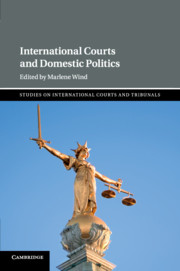Book contents
- International Courts and Domestic Politics
- Studies on International Courts and Tribunals
- International Courts and Domestic Politics
- Copyright page
- Contents
- Figures
- Tables
- Contributors
- Abbreviations
- Preface
- Introduction
- 1 ‘Missing in Action? The Rare Voice of International Courts in Domestic Politics’
- Part I
- Part II
- 8 Ideology and International Human Rights Commitments in Post-Communist Regimes: The Cases of the Czech Republic and Slovakia
- 9 Escalation and Interaction: International Courts and Domestic Politics in the Law of State Immunity
- 10 National Parliaments: Obstacles or Aid to the Impact of International Human Rights Bodies?
- 11 The European Court of Human Rights and Swiss Politics: How Does the Swiss Judge Fit In?
- 12 The Use of International Jurisprudence by Israel’s Supreme Court
- 13 Laggards or Pioneers? When Scandinavian Avant-garde Judges Do Not Cite International Case Law: A Methodological Framework
- Index
- References
11 - The European Court of Human Rights and Swiss Politics: How Does the Swiss Judge Fit In?
from Part II
Published online by Cambridge University Press: 23 June 2018
- International Courts and Domestic Politics
- Studies on International Courts and Tribunals
- International Courts and Domestic Politics
- Copyright page
- Contents
- Figures
- Tables
- Contributors
- Abbreviations
- Preface
- Introduction
- 1 ‘Missing in Action? The Rare Voice of International Courts in Domestic Politics’
- Part I
- Part II
- 8 Ideology and International Human Rights Commitments in Post-Communist Regimes: The Cases of the Czech Republic and Slovakia
- 9 Escalation and Interaction: International Courts and Domestic Politics in the Law of State Immunity
- 10 National Parliaments: Obstacles or Aid to the Impact of International Human Rights Bodies?
- 11 The European Court of Human Rights and Swiss Politics: How Does the Swiss Judge Fit In?
- 12 The Use of International Jurisprudence by Israel’s Supreme Court
- 13 Laggards or Pioneers? When Scandinavian Avant-garde Judges Do Not Cite International Case Law: A Methodological Framework
- Index
- References
Summary
The relationship between Swiss politics and the European Court of Human Rights cannot be understood without emphasising the pivotal role played by domestic courts’ interpretations of the European Convention. Swiss semi-direct democracy has been challenging the authority of the European Court of Human Rights and of the European Convention on Human Rights for decades, yet many of the tensions arising between the European Court and Swiss politics are appeased by the way Swiss judges interpret the Convention. By applying the interpretative principles required by the Convention and set out in the judgments of the European Court, Swiss courts prevent conflicts between the Convention and the Swiss legal order. On the other hand, the transparent and differentiated interpretative language Swiss courts use also helps them convince the European Court that the domestic polity does respect its obligations under the Convention. Several features of the Swiss legal order, especially its federal political organisation and its openness towards international law, facilitate Swiss courts’ mediating role. However, eventually, Swiss judges’ interpretative choices and methods ensure to an important extent that the European Court and Swiss politics accept each other’s respective decisions.
- Type
- Chapter
- Information
- International Courts and Domestic Politics , pp. 262 - 295Publisher: Cambridge University PressPrint publication year: 2018
References
- 1
- Cited by

